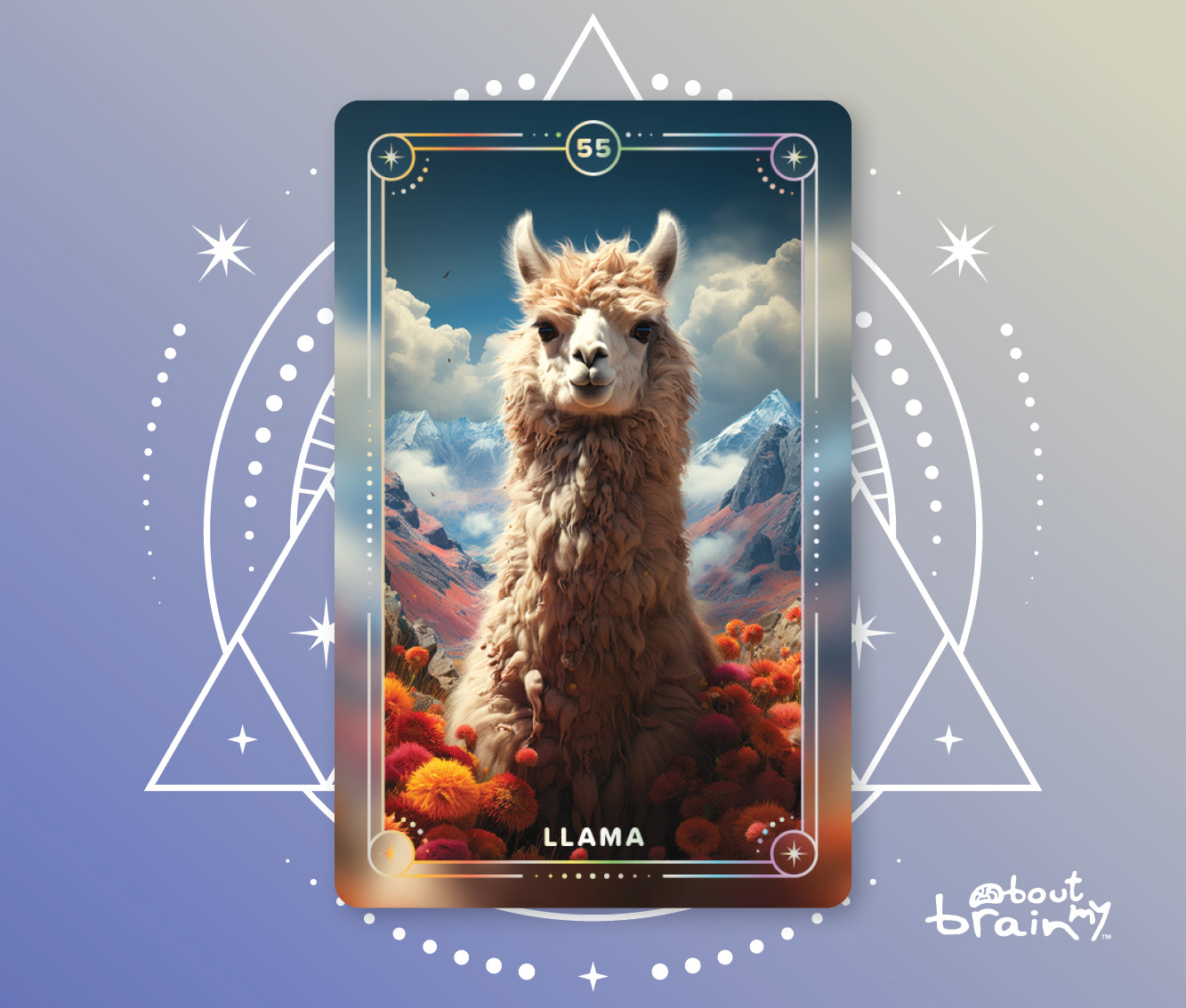
Llama
Cooperation, Reliability and Strength.

Discovering The Llama Spirit
The llama stands as a symbol of endurance, community, and gentle strength. At the core of the llama's symbolism lies the essence of cooperative spirit. With their ability to traverse challenging terrains while bearing heavy loads, llamas epitomize the virtues of resilience and reliability.
In their role as vital members of Andean communities, llamas highlight the importance of mutual support and togetherness. The spiritual essence of the llama teaches us the power of collaboration and the magic of collective endeavors.
Furthermore, the llama signifies the journey of balanced responsibility. Their dedicated and steady nature reminds us of the importance of shouldering our duties with grace, while also understanding our limits. The spiritual guidance of the llama encourages us to find balance in our endeavors, to approach tasks with dedication, and to recognize the value of shared efforts.
Beyond endurance, community, and responsibility, the llama's wisdom also points us toward humility. With their gentle demeanor and unwavering commitment, llamas serve as a reminder of the strength inherent in gentleness. The spiritual teachings of the llama inspire us to lead with kindness, to foster community bonds, and to face life's mountains with unwavering determination and a kind heart.
Prefer to listen to this article?
Check out our podcast!
Newsletter
Keep reading ↓
- Spirit Animals ↓
- See All
- Alligator
- Anaconda
- Ant
- Arabian Oryx
- Beaver
- Bee
- Beetle
- Black Bear
- Buffalo
- Butterfly
- Camel
- Cat
- Cheetah
- Chimpanzee
- Condor
- Coyote
- Crab
- Dog
- Dolphin
- Dove
- Dragonfly
- Elephant
- Elk
- Emu
- Falcon
- Flamingo
- Fox
- Frog
- Gazelle
- Giraffe
- Goose
- Gorilla
- Grasshopper
- Hawk
- Hedgehog
- Hippopotamus
- Horse
- Hummingbird
- Hyena
- Jaguar
- Kangaroo
- Kiwi
- Koala
- Koi Fish
- Komodo Dragon
- Kookaburra
- Ladybug
- Lamb
- Lemur
- Lion
- Lizard
- Llama
- Manatee
- Mandarin Duck
- Meerkat
- Monkey
- Moose
- Mountain Goat
- Mouse
- Nightingale
- Octopus
- Orca Whale
- Otter
- Owl
- Ox
- Panda
- Panther
- Parrot
- Peacock
- Polar Bear
- Quetzal
- Rabbit
- Raccoon
- Raven
- Rhinoceros
- Rooster
- Salmon
- Sea Turtle
- Seahorse
- Shark
- Sloth
- Snake
- Snow Leopard
- Spider
- Squirrel
- Starfish
- Swan
- Tiger
- Tortoise
- Whale
- Wolf
- Wombat
- Zebra
What Does The Llama Represent?
Llamas, native to the high altitudes of the Andes Mountains, are revered for their myriad qualities that make them both unique and indispensable. Known for their resilience and adaptability, llamas are equipped to traverse rugged terrains, demonstrating unparalleled endurance. This remarkable stamina is matched by their gentle strength; they are robust creatures, yet their demeanor is calm and composed, rarely showing signs of agitation. Besides their physical attributes, llamas are also characterized by their social nature. They thrive in communal settings, emphasizing the importance of teamwork and collaboration. Moreover, their intelligence and curious nature make them quick learners and responsive to training. With expressive eyes and a serene presence, llamas exude a sense of quiet wisdom, commanding respect and admiration from those fortunate enough to interact with them. Their combination of strength, patience, and sociability positions them as truly remarkable creatures in the animal kingdom.
Keep reading ↓
Supporting content
Cultural and Mythological Significance Of The Llama Spirit
Llamas, for centuries, have been interwoven into the cultural and mythological fabric of South American civilizations, particularly among the Andean communities.
In the ancient Incan civilization, llamas were more than just pack animals. They held a prominent place in society, symbolizing wealth and status. Being the primary beast of burden in the vast Incan empire, llamas played a crucial role in trade and transportation across the challenging mountain terrains. Furthermore, they provided essential resources: their wool was used for clothing, their meat for food, and their bones for tools. Ceremonial sacrifices of llamas were also practiced, believed to appease the gods and bring about fertility and good harvests.
In Andean mythology, llamas are often associated with the origin of life and sustenance. Legends tell of their divine creation, where they emerged from rivers and lakes as gifts from the gods. Their close relationship with water sources symbolized their role as life-bringers and nurturers.
Today, the legacy of the llama continues to be celebrated. Festivals across the Andean regions honor these animals, acknowledging their continued importance in daily life. Llamas have also gained global recognition and appreciation, becoming symbolic of South American identity and pride.
Supporting content
Keep reading ↓
A Llama In My Deams
Dreaming of a llama can serve as a deep reflection of one's inner psyche, mirroring various facets of their waking life. Known for their endurance in navigating tough terrains, the presence of a llama in dreams might symbolize an individual's journey or challenges, acting as a comforting reminder of one's inherent strength and resilience. Inherently social, the appearance of these creatures could also highlight the significance of community and teamwork, suggesting a possible need to lean on or unite with others. Given their role in many cultures as carriers of burdens, they might denote responsibilities or obligations that weigh on the dreamer.
Their strong ties to South American traditions could also signify a longing to reconnect with ancestral roots or an appreciation for ancient wisdom. Above all, the calm yet unwavering nature of the llama can emphasize the power of facing adversities with grace and patience. Interpreting such dreams requires careful consideration of the dream's context and the emotions it evokes, ensuring the message is tailored to the dreamer's unique experiences.
Keep reading ↓
Habitat, Behaviours and Ecological Importance Of The Llama
Habitat:
Llamas are native to the high-altitude regions of the Andes Mountains in South America, spanning across countries like Peru, Bolivia, Chile, and Argentina. These hardy creatures thrive in the rugged terrains and thin atmosphere of the Andean highlands, which can range from grassy plateaus to steep, rocky slopes. Adapted to this challenging environment, llamas have evolved with specially designed feet for stability and large lungs to efficiently process the oxygen-scarce air. The Andean climate, characterized by its cool temperatures and sparse vegetation, has shaped the dietary habits and woolly coats of the llamas, preparing them to endure both the cold nights and the intense sun during the day. In this unique habitat, llamas play an integral role in the ecosystem, grazing on grasses and shrubs, and in turn, influencing the landscape's vegetation dynamics.
Behaviours:
- Social Herding: Llamas are inherently social animals, typically found in groups known as herds. They establish a clear hierarchical structure within these groups, with dominant llamas leading the herd and setting boundaries. Social interactions, including grooming and playing, strengthen bonds within the group.
- Spitting as Defense: One of the most notorious behaviors of llamas is their tendency to spit. While they usually reserve spitting for disagreements within their herd, particularly during disputes over food or hierarchy, they can also spit at perceived threats, including humans, as a defensive mechanism.
- Humming as Communication: Llamas communicate using a range of vocalizations, with humming being the most common. The reasons for their humming can vary, from expressing curiosity or discomfort to signaling alertness in the presence of a potential threat.
- Dust Bathing: To keep their thick wool clean and free from parasites, llamas often partake in dust bathing. They roll and rub their bodies in dust or dirt, which helps to remove unwanted debris and excess oil from their fur.
- Protective Instincts: Llamas possess strong protective instincts, especially when it comes to guarding their territory or herd. This trait has made them valuable as "guard llamas" in various parts of the world, where they are employed to protect livestock, like sheep or goats, from predators. Their keen sense of sight and hearing allows them to detect potential threats from a distance, and they won't hesitate to chase away or confront intruders.
Ecological Importance:
Llamas play a vital role in the ecological balance of their native Andean habitats. As primary herbivores, they graze on grasses and shrubs, promoting plant diversity by preventing any single species from becoming too dominant. Their grazing habits can also help in controlling the spread of potential fire-fueling vegetation, mitigating wildfire risks in certain regions. Furthermore, the dung of llamas serves as an essential nutrient source for the soil, enhancing its fertility and aiding in the growth of native flora. This cyclical process of grazing and nutrient deposit establishes llamas as pivotal components in nutrient cycling within the Andean ecosystems. In regions where agriculture is predominant, llamas also play a crucial role in sustainable farming practices. Their gentle tread has a minimal impact on the soil, reducing erosion and ensuring that the land remains arable for future generations.
Keep reading ↓
How the Llama Contributes To Scientific Research
The llama, native to the South American Andes, has a unique contribution biomedicine. One of the most fascinating aspects of llamas lies in their antibodies. Unlike most mammals that produce the typical Y-shaped antibodies, llamas (and other camelids) produce a simpler, single-chain variety of antibody. These smaller, more stable antibodies, known as nanobodies, can access regions of proteins that are difficult for conventional antibodies to bind. This unique feature has opened doors to potential therapeutic applications, such as in the development of drugs and diagnostic methods for a wide array of diseases, including viral infections like COVID-19. The llama's distinct immune response exemplifies the myriad of ways in which diverse organisms can offer innovative solutions to complex scientific challenges.
Keep reading ↓
Guided Visualization To Connect With The Llama Spirit
Complement your ritual with...
Binaural beats!
- Begin by finding a quiet and comfortable space where you won't be disturbed. Sit or lie down, and take a moment to close your eyes, allowing the external world to fade away. Feel the support of the ground beneath you, anchoring you in this present moment.
- Focus on your breathing. Inhale deeply through your nose, feeling your lungs expand, and then exhale gently through your mouth. With each breath, feel any tension or stress melt away.
- Imagine yourself on a journey to the high-altitude regions of the Andes Mountains. Picture the vast landscapes, with rolling green hills, rocky terrains, and distant snow-capped peaks. The air is crisp and refreshing.
- As you traverse this landscape, you spot a majestic llama standing on a hill, bathed in the soft glow of the sun. Its calm and gentle eyes meet yours, inviting you to approach.
- As you draw nearer, you sense the profound wisdom and strength this creature embodies. Sit or stand beside the llama, and feel its spirit connecting with yours. It emanates a warm, protective energy, reminding you of the power of resilience, community, and tradition.
- Allow yourself a moment to communicate with the llama. If you have questions or seek guidance, now is the time to ask. The llama, with its deep-rooted wisdom, might offer insights, feelings, or images in return.
- Spend a few moments in silent gratitude for this connection and the wisdom shared. Feel the bond between you and the llama spirit, recognizing its presence as a guiding force in your life.
- Slowly begin to distance yourself from the Andean landscape, keeping the spirit of the llama close to your heart. Gradually become aware of your surroundings, the ground supporting you, and the rhythm of your breathing.
- When you're ready, take a deep, invigorating breath, bringing movement to your fingers and toes. Gently open your eyes, returning to the present, carrying the essence of the llama spirit with you.
Shop
Connect with the essence of our Spirit Animals!

Beach Towel
Buy Now

Flag Wall Art
Buy Now

Sherpa Blanket
Buy Now

Oracle Decks
Buy Now
From Our Blog
Stay up to date with our latest articles!

Jane Goodall’s Legacy: Lessons On Leadership And Compassion

Empowering Leaders Through Personal Growth with Gail Eaton-Briggs

From Digital Lovers To Grandmothers-For-Hire: What Japan Teaches Us About Loneliness
Please note:
It is crucial to acknowledge that the symbology and interpretations can differ greatly among various cultures, religious ideologies, and individual viewpoints. The significance and comprehension of these spirit animals may vary depending on the particular mythological backdrop or the spiritual and philosophical framework through which they are approached. The descriptions of these Oracle Cards are based on information gathered from various sources. Our aim is to provide an overview and a fictional interpretation and we cannot guarantee the accuracy or completeness of this information. The artwork featured on these Oracle Cards have been crafted by digital artists and designers, Relmi Damiano and Sacha Damiano, in conjunction with Artificial Intelligence that has been enhanced by human intervention. The visual imagery serves as a fictional representation of some of the symbols associated with these goddesses throughout history.

